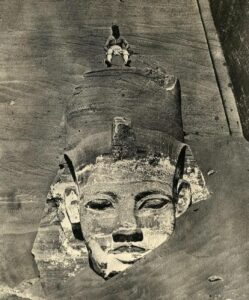1. A Historic Image at Abu Simbel
A vintage photograph captures a man perched on the top of one of Abu Simbel’s colossal statues – a famous temple in Egypt, constructed during the reign of Pharaoh Ramses II. Before modern excavations, the desert sands had nearly engulfed the statues, covering them almost to the head, as if these giants were sinking into the sand.

2. The Rediscovery of a Heritage Site
Before the excavations began, Abu Simbel lay hidden beneath layers of Nubian desert sand, seemingly forgotten by time. For the excavation team, the task wasn’t just about digging; it was a journey to recover the past, a struggle against nature to bring back a part of an ancient civilization. With the sands encroaching daily, the team had to remove tons of sand, slowly revealing each part of the statue until the magnificent temple was fully exposed.
3. The Monumental Scale of the Statues
The man sitting atop the statue provides a crucial sense of scale in the photograph. He appears as a tiny dot next to the massive face of Ramses, allowing us to grasp the incredible size and craftsmanship of these sculptures. Standing at around 20 meters tall, the statues tower over any average person, making the man in the photo appear insignificantly small by comparison.

4. The Archaeological Significance of Abu Simbel
The excavation of Abu Simbel was not merely about revealing an impressive structure; it was about restoring a crucial part of ancient Egyptian history. The statues at Abu Simbel were created not only to honor Ramses II but also to assert his power and influence over the Nubian territories. The temple’s preservation and excavation have given researchers valuable insights into the life and beliefs of the ancient Egyptians.
5. The Impact of Climate on Preservation Efforts
The excavation and preservation of Abu Simbel also highlight the challenges posed by nature. Abu Simbel faces not only the erosion of time but also the threat of the Nile River. In the 1960s, the construction of the Aswan Dam caused rising water levels, putting the entire temple at risk of submersion. To save this heritage, an ambitious relocation and reassembly project was undertaken from 1964 to 1968.

6. Cultural and Touristic Impact
Today, Abu Simbel is not only an important archaeological site but also a popular tourist attraction, drawing millions of visitors from around the world. The statues represent not only the power of Ramses II but also symbolize the resilience and ability of humanity to preserve history against the forces of nature. The successful preservation and relocation have made Abu Simbel a model of cultural heritage conservation.
7. Conclusion: The Grandeur and Endurance of an Ancient Legacy
The photograph of the small man atop the statue at Abu Simbel is not only a historic snapshot but also a reminder of the grand scale of ancient constructions and our determination to protect cultural heritage. Through centuries, Abu Simbel has shown that neither nature nor time can fully erase a legacy that has stood for thousands of years.
